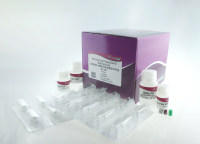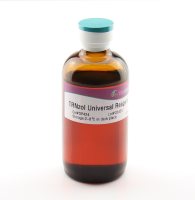Preparation of RNA from Cultured Cells
互联网
602
Preparation of RNA from Cultured Cells Notes: When preparing solutions for use with RNA, use only MilliQ water and disposable sterile Tissue Culture plasticware. Also, if preparing working solutions from stock solutions (e.g., 0.5 M EDTA pH 8.0 or 1.0 M NaCl), make sure that the stocks were also prepared in sterile plasticware with MilliQ. To rinse the homogenizer, set up a series of 3 Erlenmeyer flasks. Fill each with MilliQ water and add a little SDS to the first flask. To rinse, go from the first flask to the next, turning the homogenizer on at each step. 1. Wash the cells twice with PBS. Add 3 ml trypsin per 10 cm plate, swirl to cover the surface, and incubate for 10 minutes. 2. Add 3 ml of M15 to neutralize the trypsin and resuspend the cells by vigorous pipetting. 3. Pool the cells in a 50 ml polypropylene tube. Pellet the cells by centrifugation @ 1,000 rpm for 5 minutes. 4. Aspirate off the supernatant and add 8 ml of ice-cold Lysis Buffer (6 M Urea, 3 M LiCl, 1 mM EDTA pH 8.0 in MilliQ water). Keep samples on ice. 5. Homogenize samples on ice @ maximum speed for 1.5 minutes to destroy the cells and break down the genomic DNA. Rinse the homogenizer between one sample and the next. 6. Transfer the lysates to 15 ml polypropylene tubes (these tubes must be able to resist high-speed centrifugation). Place the tubes in an ice bucket (with ice) and store overnight @ 4o C. 7. Centrifuge the samples @ 10,000 rpm for 30 minutes @ 4o C (use the Sorvall HB-4 or SA-600 rotors; adapters will be required for the tubes). 8. Discard the supernatant. Invert the tubes onto paper towels to thoroughly drain. 9. Resuspend the pellet in a total volume of 0.4 ml of Solution (10 mM Tris pH 8.0, 0.5% SDS prepared in MilliQ water). Add the solution 0.1 ml at a time, resuspend the pellet, and transfer the RNA to microcentrifuge tubes on ice. Repeat with subsequent 0.1 ml volumes, transferring each wash to the microcentrifuge tubes, until the total 0.4 ml has been added. 10. Extract once with an equal volume of phenol, once with an equal volume of phenol/chloroform, and once with an equal volume of chloroform. Avoid carrying the interphase between one extraction and the next. 11. Precipitate the RNA by adding NaCl to 0.15 M and 2.5 volumes of cold EtOH. Invert the tubes a few times and store @ -70o C for 1 hour (or overnight @ -20o C). 12. Spin samples in the microcentrifuge @ maximum speed for 10 minutes in the cold room. 13. Aspirate off the supernatant and rinse the pellet with 70% EtOH. Allow to air dry a little. 14. Resuspend the RNA pellet in 0.1 ml of DEPC-treated H2O (DEPC=diethylpyrocarbonate; add 1 ml to 1 L of MilliQ water, mix, and leave overnight @ 37o C, then autoclave). Vortex vigorously to force resuspension. 15. Transfer 1 ul of sample to a clean microcentrifuge tube, dilute 1:500 with dH2O, and read A260. RNA concentration (ug/ul) = A260 multiplied by 20. 16. Store the RNA samples @ -20o C. The RNA is ready for electrophoresis. From the Laboratory of Dr. Allan Bradley Baylor College of Medicine, Houston, Texas








